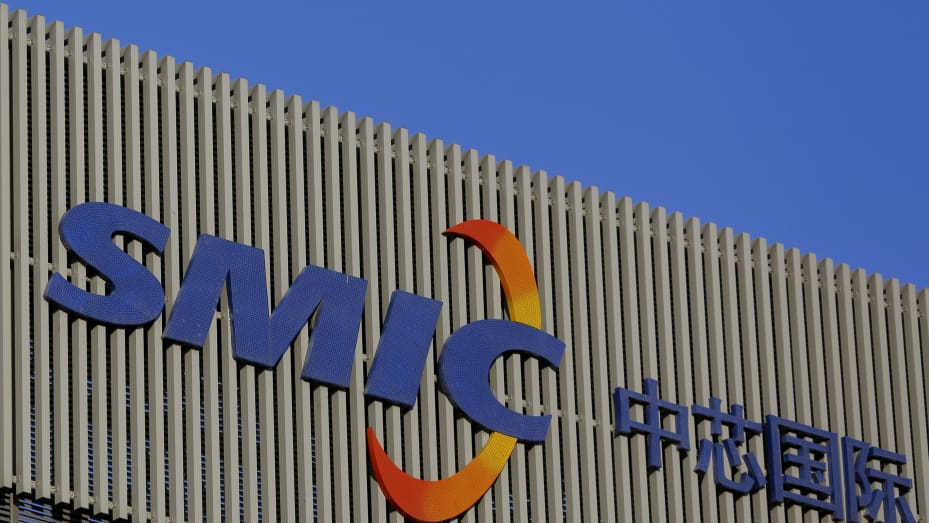Sheila Chiang

China’s largest chipmaker SMIC won’t be able to produce cutting-edge chips competitively if it continues to be cut off from advanced equipment, analysts told CNBC.
SMIC has been the target of U.S. sanctions since 2020 when it was put on an U.S. trade blacklist restricting its access to certain technology.
It has been unable to obtain the extreme ultraviolet lithography machines which only Dutch firm ASML is currently capable of making.
But with SMIC being the key to China’s chip ambitions, analysts expect the government to step up support for the chipmaker.
China’s largest chipmaker SMIC won’t be able to produce cutting-edge chips competitively if it continues to be cut off from advanced equipment, analysts told CNBC.
China’s largest chipmaker SMIC won’t be able to produce cutting-edge chips competitively if it continues to be cut off from advanced equipment, analysts told CNBC.
State-backed SMIC, or Semiconductor Manufacturing International Co., is making 7-nanometer semiconductor chips, placing it in the league of Intel and others.
However, SMIC has been the target of U.S. sanctions since 2020 when it was put on a U.S. trade blacklist which restricts its access to certain technology. It has also been unable to obtain the extreme ultraviolet (EUV) lithography machines — which only Dutch firm ASML is capable of making.
“It’s just not commercially profitable for SMIC to make those chips with less advanced equipment,” said Phelix Lee, equity analyst for Morningstar Asia.
Following the 2020 sanctions, the U.S. last year introduced sweeping export restrictions aimed at cutting China off from advanced chip tech and equipment. Washington is concerned that China could use these advanced semiconductors in artificial intelligence and military applications.
The U.S. has sought support from other key chipmaking nations including South Korea, Japan and the Netherlands. The Netherlands as well as Japan have reportedly followed the U.S. in imposing rules aimed at restricting China from accessing advanced chip tech.
According to Dutch regulations, ASML will need to apply for a license to export its EUV machines. ASML has not exported the highly complex machines to China so far.
“Can SMIC produce in a commercially viable way scaled by the hundreds of thousands or tens of millions in some cases? That’s what the most advanced tools let you do,” Chris Miller, author of “Chip War” told CNBC.
SMIC did not respond to CNBC’s request for comment.
Competitive landscape
The world’s most advanced chip facilities — such as Taiwan Semiconductor Manufacturing Company and South Korean electronics giant Samsung — rely on tools from just a small number of companies largely in the U.S., Japan and the Netherlands.
TSMC and Samsung began mass producing 7-nanometer chips in 2018. Both firms use ASML’s EUV machines.
“Nanometer” in chips refers to the size of individual transistors on a chip. The smaller the size of the transistor, the more of them can be packed onto a single semiconductor. As such, smaller nanometer sizes typically yield more powerful and efficient chips.
Both companies have a roadmap to produce 2-nanometer chips in 2025. Samsung will begin making 1.4-nanometer chips in 2027. Both companies started mass production of 3-nanometer chips last year.
Still lagging behind
SMIC is still generations behind TSMC and Samsung. Without advanced chip-making machines, SMIC is going to fall further behind.
“So far I don’t see domestic players being able to provide those machines to SMIC,” said Morningstar’s Lee.
At least for the next couple of years, SMIC is going to struggle to produce chips that are as effective and as high quality as those that are produced abroad.
While some Chinese firms are trying to build equivalent tools domestically, they remain fairly far behind, said Miller.
In February, ASML said that a former employee in China had stolen data about its proprietary technology.
“It will likely take some time before China begins to replicate the capabilities that these important tools have,” said Miller, who is also an international history professor at Tufts University.
“At least for the next couple of years, SMIC is going to struggle to produce chips that are as effective and as high quality as those that are produced abroad,” the professor said.

SMIC has a long way to go in catching up with TSMC, says analyst
Lee said it is “quite unlikely, at least in the next five years” for SMIC to be able to produce the latest generation of chips such as 5 or 3-nanometer chips. “If we want to close the gap [between SMIC and TSMC], we should be looking at a 10-year horizon,” said Lee.
China wants tech progress
But with SMIC being the key to China’s chip ambitions, analysts expect the government to step up support for the chipmaker. SMIC already benefits from government subsidies and state-backed research projects.
“I see a lot of financing to happen for SMIC. These can come from bank loans, issuing new shares, or setting up operating companies with the help of government funding,” said Lee.
The Chinese government has made it clear they want to get as close as possible to the cutting edge...
In its five-year development plan, China said it would increase research and development spending by more than 7% per year between 2021 and 2025, in pursuit of “major breakthroughs” in technology and self-reliance.
Domestic tech giants from Alibaba to Baidu have been designing their own chips, seen as a step toward China’s goal of boosting its domestic capabilities in chip tech.
“The Chinese government has made it clear they want to get as close as possible to the cutting edge and so a lot of the funds will be devoted towards trying to produce close to cutting edge chips,” said Miller.
“SMIC is going to benefit from a new level of support from the Chinese government which doesn’t want to see it fail and wants to see it, if possible, continue to make progress technologically,” he added.
No comments:
Post a Comment